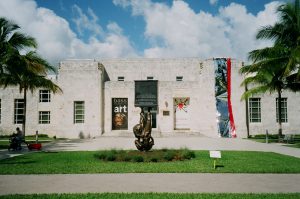Posted February 21, 2017
By KATE HOVAN
The extent of most families’ involvement in their children’s artwork is grabbing a magnet and displaying it on the refrigerator.
But what if there were a way for families to create art together and have it displayed in a well-known museum? The Bass Art Museum is making that possible, but with an added benefit.
The museum is bringing developmental art programs to families across Miami with a community outreach program known as “Creativity in the Community.” The program hosts a series of workshops in the greater Miami area where students aged 2-8 and their parents can improve and develop literacy through art.

The Bass Art Museum, 2100 Collins Ave., Miami Beach, in March 2014 (Photo courtesy of Phillip Pessar).
The three-year program, which has a storytelling component and an art component that vary each session, is funded by the W.K. Kellogg Foundation and overseen by Mariana Corbalan, the museum’s education outreach manager.
Museum ambassadors, or the artists who lead the workshops, teach at 12 locations throughout Miami on a weekly basis for six-week periods.
At each session, students and parents read a book aloud together, focusing on the both the words and the art. Then, families are challenged to retell the story through their own artwork, which hones their literacy skills as they generate the book’s message into their own masterpiece. Sessions are offered in English, Spanish or Creole to accommodate to the families’ needs.
Andrea Robbins, an ambassador and education assistant for the program, explained that the location of a workshop can set a different dynamic.
“Overtown is a hard market, because the parents are not involved,” Robbins said. “But this program is for parents and children and it’s really hard in lower economic areas to make that work. But Miami Beach is different entity because we have really involved parents.”
Overtown is located northwest of Downtown Miami and is one of the city’s oldest neighborhoods. The neighborhood is often associated with high crime rates and poverty, making participation in the “Creativity in the Community” program all the more necessary.
Dorothy Wawa, another one of the program’s ambassadors, is also a full-time art teacher at Oak Grove Elementary School. Like Robbins, Wawa also said the most difficult part of the program is getting community members to become involved, especially during the formative stages of child development.
“Children are young, and they’re like sponges,” Wawa explained. “It’s the best time for them to have an interaction with reading.”
Wawa also said she likes to use her dual roles as both a full-time teacher and an ambassador to encourage her hesitant students to participate in the program.
“I become the bridge to that unknown,” she explained. “So I say I’m going to be there, and once I start explaining that we’re going to have fun, they get addicted.”
Dr. Marilyn Neff, associate dean and research assistant professor at the University of Miami’s School of Education, is well versed in the relationship between the arts and literacy, and she teaches students about the research-based methods using art as a developmental tool.
“A thing we do here on this campus is something called VTS, or visual thinking strategy and it’s done in conjunction with the Lowe Art Museum,” Neff explained. “This is a research-based strategy that uses visual images to teach observational skills and critical thinking, and it’s very well researched. So the kids who participate in this have done better in visual literacy and communication.”
According to the VTS site, VTS teaches students to have a discussion about art images, which will develop their thinking skills and allow them to apply those skills in other areas. Neff explained that she even uses the hands-on approach for her own students at UM.
“I give a mini lecture and then we’ll actually do it to teach the habits. Sometimes it’s called studio thinking, where there are real benefits of visual art education and [they learn] why the things that you do when you’re working hands-on translate to all areas of your life.”
The program is not a one-way street, however. Corbalan stated that some families have benefitted from the program in unique ways outside of its primary purpose to improve literacy.
Families or family members who show a serious interest in the arts have the opportunity to become volunteers for the program. Volunteers give back to the program by assisting the ambassadors in their work, and they even have the opportunity to become ambassadors themselves.
“We have three teachers now that run their own programs that started off in the program as just parents participating in it,” Corbalan said.
Robbins also noted that, although the program is meant primarily to help the students, parents themselves even benefit from the workshops.
“It teaches the parents, too,” Robbins said. “We have parents coming in that are totally shy and will not talk to anyone. But by the end you see the communication between the parent and the child ”
The six-week program concludes with a culmination ceremony that displays the families’ artwork in the Bass Art Museum.
“I think what’s most rewarding to me is when the parent and child are proud of their work and they’re happy to see their work up,” Robbins said. “They become a community afterwards. They exchange numbers and stay in touch with each other.”
The ceremony is tentatively set for late May 2017 when renovations to the museum are completed.
